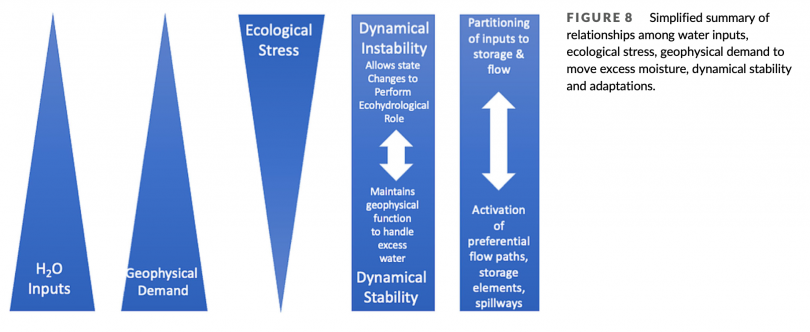Can geophysical systems adapt to changing environmental conditions or to disturbances, in a way broadly analogous to biological adaptation, but independently of any biological components? Yes, according to my analysis using the example of hydrological systems. Just published in Ecohydrology, https://doi.org/10.1002/eco.2567 and attached here.

ABSTRACT: The question of whether the concept of adaptation can be applied to Earth surface systems (independently of biological adaptation) is addressed by examining hydrological flow systems. Hydrological systems are represented in terms of a partitioning of water inputs among various flux and storage components and outflows or outputs of the system. Partitioning is contingent on the flow system in question and the synoptic situation (i.e., drier, low-input vs. wetter, high-input conditions). The general allocation among inputs, flows through or within the system, storage and outputs is examined via analysis of 20 scenarios for soil hydrology, a fluvial channel-wetland complex and a fluviokarst landscape representing different combinations of positive, negative and zero (neutral) relationships among these elements, and positive self- reinforcing and negative self-limiting effects. Conditions for stability were determined using the Routh–Hurwitz criteria and linked to the two fundamental roles or ‘jobs’ of hydrological flow systems. The ecological job is to support biota and biogeo- chemical fluxes and transformations necessary for ecosystem functions. The geophysical job is to remove excess water. Results show that low-input scenarios for the soil, fluvial wetland and fluviokarst scenarios are marked by dynamical instability. During drier periods the geophysical job is irrelevant and the ecological functions are suboptimal. Instability allows for rapid state changes when moisture inputs increase, to system states that support ecosystem functions. High-input, excess moisture and flood scenarios, by contrast, are generally dynamically stable. In wetter conditions, the ecological functions are not moisture-stressed, and the geophysical job becomes paramount. The high-input stability is associated with activation of ‘spillway’ mechanisms that allow the systems to maintain themselves by efficient export and augmented storage of excess water. Contingent partitioning indeed appears to be an adaptation mechanism in hydrological systems and suggests the possibility of adapta- tion in other Earth surface systems with important abiotic components.
